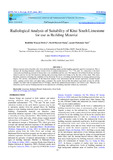| dc.contributor.author | Patel, Jayanti P | |
| dc.contributor.author | Maina, David M | |
| dc.contributor.author | Mulwa, Bendibbie M | |
| dc.date.accessioned | 2015-03-05T11:10:22Z | |
| dc.date.available | 2015-03-05T11:10:22Z | |
| dc.date.issued | 2013 | |
| dc.identifier.citation | Mulwa, Bendibbie Munyao, David Muchori Maina, and Jayanti Pushotami Patel. "Radiological Analysis of Suitability of Kitui South Limestone for use as Building Material." International Journal of Fundamental Physical Sciences 3.2 (2013). | en_US |
| dc.identifier.uri | http://hdl.handle.net/11295/80979 | |
| dc.description.abstract | Indoor exposure arises from the soils from which the building stands and the building materials used for construction. This is
because all building materials contain certain levels of natural radionuclides 238U, 232Th, and 40K. Limestone is the most
commonly used building material in Kenya due to its availability and low cost. The limestone from Kitui South has not been
mined to process for use but limestone mining and processing plants were being set by the time of this study. This study
therefore aimed at evaluating the suitability of the limestone for use as a building material before its mining and processing
begins. The activity concentrations of the limestone samples were determined and the radium equivalent, external hazard
index, gamma activity index and alpha index evaluated. The results showed that the radium equivalent activity for all the
samples was below the recommend limit of 370Bqkg-1 and all the radiation hazard indices were below a unit. Therefore, the
limestone can be used as building material or for manufacture of building materials without any restrictions. | en_US |
| dc.language.iso | en | en_US |
| dc.title | Radiological Analysis of Suitability of Kitui South Limestone for use as Building Material | en_US |
| dc.type | Article | en_US |
| dc.type.material | en_US | en_US |

